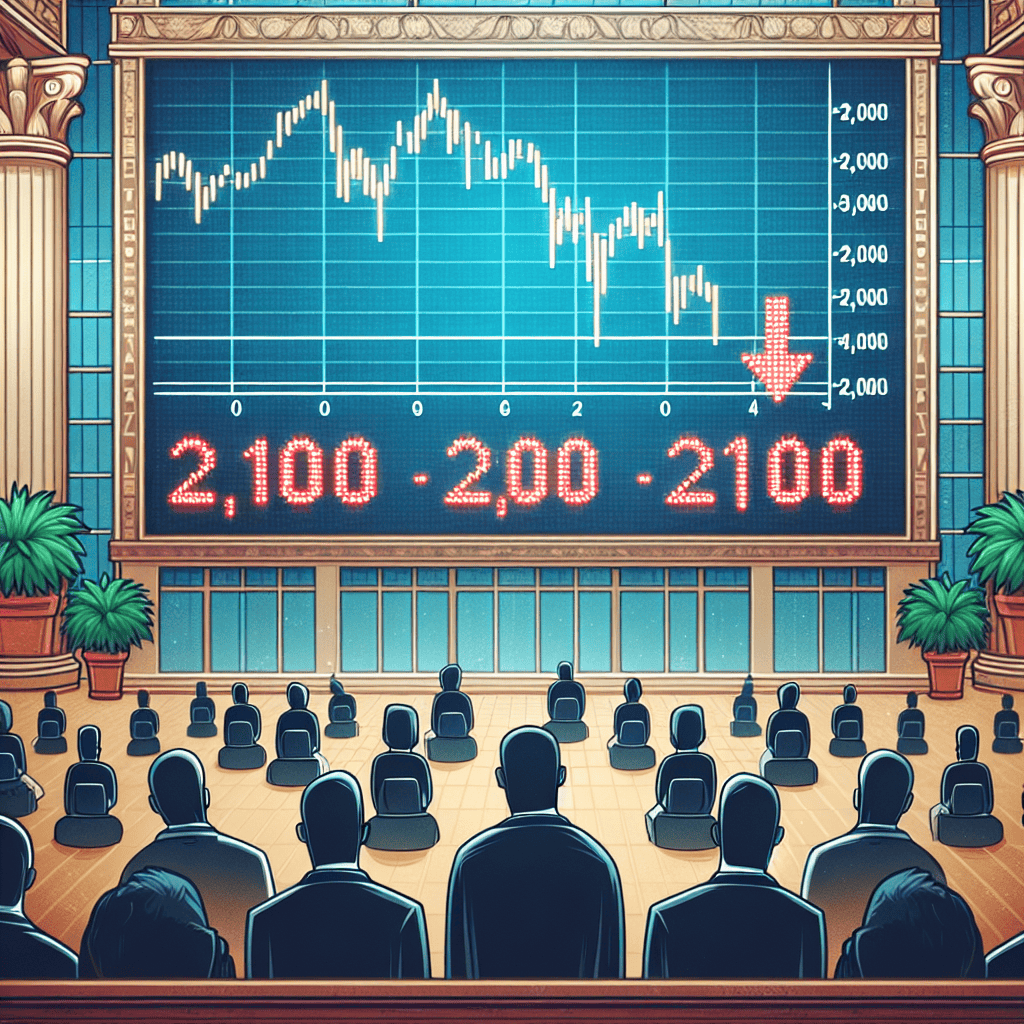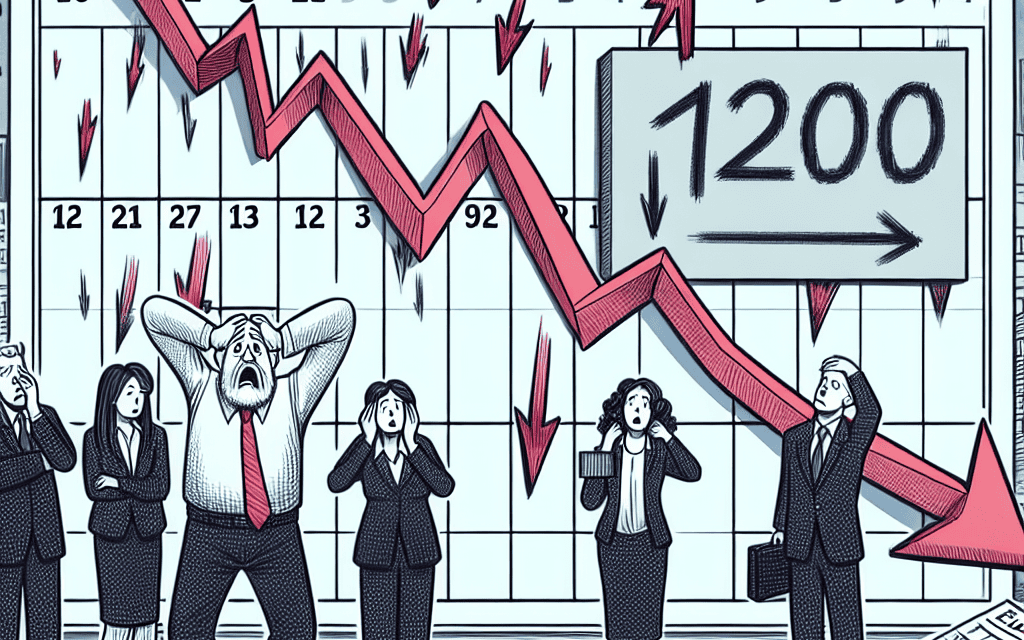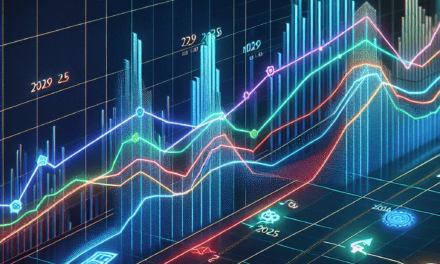“Market Jitters: Dow Dips 200 Points Ahead of Election Day Uncertainty”
Introduction
On the eve of a pivotal Election Day, the stock market experienced a notable downturn, with the Dow Jones Industrial Average falling by 200 points. This decline reflects the heightened uncertainty and cautious sentiment among investors as they brace for the potential economic and policy shifts that could follow the election results. Market participants are closely monitoring the political landscape, aware that the outcome could significantly influence fiscal policies, regulatory changes, and overall market stability. As investors navigate this period of unpredictability, the dip in the Dow underscores the broader apprehension and strategic repositioning occurring within financial markets.
Market Volatility: Understanding the Dow’s 200-Point Drop
As Election Day approaches, the financial markets are experiencing heightened volatility, with the Dow Jones Industrial Average recently falling by 200 points. This decline reflects the uncertainty that often accompanies major political events, as investors attempt to navigate the potential implications of electoral outcomes on economic policies and market conditions. Understanding the factors contributing to this market volatility is crucial for investors seeking to make informed decisions during this tumultuous period.
To begin with, the stock market is inherently sensitive to political developments, and the upcoming election is no exception. Investors are closely monitoring the potential shifts in fiscal and regulatory policies that could arise from a change in administration or congressional control. These policy changes can have significant impacts on various sectors, influencing corporate profits, consumer spending, and overall economic growth. Consequently, the anticipation of such changes can lead to increased market fluctuations as investors adjust their portfolios in response to perceived risks and opportunities.
Moreover, the current economic landscape adds another layer of complexity to the situation. The global economy is still grappling with the aftermath of the COVID-19 pandemic, which has left many countries facing challenges such as supply chain disruptions, labor shortages, and inflationary pressures. These issues have already contributed to market volatility, and the uncertainty surrounding the election only exacerbates these concerns. Investors are particularly wary of how new policies might address or exacerbate these existing economic challenges, further influencing their investment strategies.
In addition to domestic factors, international considerations also play a role in the market’s recent movements. Geopolitical tensions, trade relations, and global economic conditions can all impact investor sentiment and market performance. For instance, changes in trade policies or international alliances resulting from the election could affect multinational corporations and global supply chains, thereby influencing stock prices and market indices. As a result, investors must consider both domestic and international factors when assessing the potential impact of the election on the markets.
Furthermore, it is important to recognize the role of investor psychology in driving market volatility. During periods of uncertainty, emotions such as fear and anxiety can lead to increased market activity, as investors react to news and speculation. This can result in rapid buying or selling, contributing to sharp market movements. Understanding this psychological component is essential for investors aiming to maintain a level-headed approach amidst the noise and speculation that often accompany election cycles.
Despite the current market volatility, it is crucial for investors to maintain a long-term perspective. While short-term fluctuations can be unsettling, history has shown that markets tend to stabilize over time as uncertainties are resolved and new policies are implemented. By focusing on long-term investment goals and maintaining a diversified portfolio, investors can better weather the storm of election-related volatility.
In conclusion, the Dow’s recent 200-point drop serves as a reminder of the complex interplay between political events, economic conditions, and investor psychology that drives market volatility. As Election Day approaches, investors must navigate these uncertainties with a careful and informed approach, considering both domestic and international factors. By maintaining a long-term perspective and focusing on sound investment principles, investors can position themselves to manage the challenges and opportunities that arise during this critical period.
Election Day Uncertainty: How It Impacts Investor Sentiment
As Election Day approaches, the financial markets are experiencing heightened volatility, with the Dow Jones Industrial Average recently falling by 200 points. This decline underscores the pervasive uncertainty that often accompanies major political events, particularly elections, which can significantly impact investor sentiment. The anticipation of potential policy shifts and economic changes under a new administration can lead to cautious behavior among investors, who may choose to adjust their portfolios in response to perceived risks and opportunities.
Historically, elections have been periods of increased market volatility, as investors grapple with the uncertainty of future economic policies. The current election cycle is no exception, with market participants closely monitoring the political landscape for any indications of how the outcome might influence fiscal and monetary policies. This uncertainty is compounded by the fact that different political parties often have divergent views on issues such as taxation, regulation, and government spending, all of which can have profound implications for the economy and, by extension, the stock market.
In addition to domestic policy concerns, investors are also considering the potential impact of the election on international relations and trade agreements. Changes in leadership can lead to shifts in foreign policy, which may affect global markets and international trade dynamics. For instance, a more protectionist stance could lead to increased tariffs and trade barriers, potentially disrupting supply chains and affecting corporate earnings. Conversely, a more open approach to trade might foster international cooperation and economic growth, benefiting multinational corporations and boosting investor confidence.
Moreover, the current economic environment adds another layer of complexity to the situation. With inflationary pressures persisting and central banks around the world navigating the delicate balance between stimulating growth and curbing inflation, the outcome of the election could influence monetary policy decisions. Investors are keenly aware that changes in interest rates can affect borrowing costs, consumer spending, and corporate profitability, all of which are critical factors in determining market performance.
As investors prepare for Election Day, many are adopting a more defensive strategy, seeking to mitigate risk by diversifying their portfolios and increasing their holdings in traditionally safer assets such as bonds and gold. This shift in strategy reflects a desire to protect against potential market downturns while remaining poised to capitalize on opportunities that may arise post-election. Additionally, some investors are turning to options and other derivatives as a means of hedging against volatility, further illustrating the cautious approach being taken in light of the current uncertainty.
Despite the challenges posed by election-related uncertainty, it is important to recognize that markets are inherently forward-looking and tend to stabilize once the political landscape becomes clearer. Historically, market volatility tends to subside in the weeks following an election, as investors gain a better understanding of the new administration’s policy priorities and adjust their strategies accordingly. In the meantime, maintaining a long-term perspective and focusing on fundamental economic indicators can help investors navigate the current environment with greater confidence.
In conclusion, the recent decline in the Dow Jones Industrial Average highlights the impact of election-related uncertainty on investor sentiment. As Election Day draws near, market participants are grappling with the potential implications of political changes on domestic and international policies. By adopting a cautious approach and remaining vigilant, investors can better position themselves to weather the current volatility and capitalize on future opportunities as the political landscape evolves.
Historical Trends: Stock Market Behavior During Election Years
As Election Day approaches, the stock market often becomes a focal point for investors seeking to anticipate the potential economic impacts of political change. Historically, the behavior of the stock market during election years has been characterized by heightened volatility and uncertainty, as market participants attempt to gauge the implications of various electoral outcomes. This year is no exception, with the Dow Jones Industrial Average recently falling 200 points, reflecting the market’s apprehension as investors brace for the upcoming election.
To understand the current market dynamics, it is essential to examine historical trends in stock market behavior during election years. Traditionally, the stock market tends to experience increased volatility in the months leading up to an election. This is largely due to the uncertainty surrounding potential policy changes that could arise from a shift in political power. Investors often react to the perceived economic policies of the candidates, which can lead to fluctuations in stock prices as market sentiment shifts.
Moreover, the stock market’s performance during election years can be influenced by the incumbent party’s perceived economic track record. For instance, if the economy is performing well under the current administration, investors may anticipate continuity and stability, potentially leading to a more favorable market environment. Conversely, if economic conditions are perceived as unfavorable, investors might expect significant policy changes, resulting in increased market volatility.
In addition to these factors, the stock market’s behavior during election years can also be affected by broader economic conditions. For example, during periods of economic expansion, the market may be more resilient to election-related uncertainties. Conversely, during economic downturns, the market may be more sensitive to political developments, as investors seek reassurance regarding future economic policies.
Furthermore, it is important to consider the role of investor psychology in shaping market behavior during election years. The anticipation of potential policy changes can lead to speculative trading, as investors attempt to position themselves advantageously based on their expectations of the election outcome. This speculative behavior can contribute to increased market volatility, as investors react to new information and adjust their portfolios accordingly.
Despite the inherent uncertainty associated with election years, historical data suggests that the stock market tends to recover and stabilize following the election. Once the results are known and the political landscape becomes clearer, investors often regain confidence, leading to a more stable market environment. This pattern underscores the importance of maintaining a long-term perspective when navigating the stock market during election years.
In conclusion, the recent 200-point drop in the Dow Jones Industrial Average serves as a reminder of the stock market’s sensitivity to political developments during election years. By examining historical trends, it becomes evident that increased volatility and uncertainty are common features of the market during this period. However, it is also important to recognize that the market has historically demonstrated resilience, often stabilizing once the election results are known. As investors prepare for Election Day, understanding these historical patterns can provide valuable insights into the potential behavior of the stock market, helping to inform investment strategies in the face of political uncertainty.
Investor Strategies: Navigating Market Fluctuations Pre-Election

As Election Day approaches, investors are keenly aware of the potential market volatility that often accompanies such significant political events. The recent drop of 200 points in the Dow Jones Industrial Average serves as a stark reminder of the uncertainty that can grip financial markets during this period. Historically, elections have been pivotal moments that can lead to substantial shifts in market sentiment, driven by the anticipation of policy changes and economic strategies that a new administration might implement. Consequently, investors are now strategizing to navigate these fluctuations with a focus on preserving capital and identifying opportunities that may arise from the evolving political landscape.
In the days leading up to an election, market participants often exhibit heightened sensitivity to news and developments that could influence the outcome. This sensitivity is reflected in increased market volatility, as traders react to polls, debates, and other indicators of electoral trends. The recent decline in the Dow can be attributed to a combination of factors, including investor anxiety over potential policy shifts and the broader economic implications of the election results. As such, many investors are adopting a cautious approach, opting to reduce exposure to riskier assets and instead favoring more stable investments.
One strategy that investors are employing is diversification, which involves spreading investments across a variety of asset classes to mitigate risk. By diversifying their portfolios, investors can reduce the impact of any single asset’s poor performance on their overall investment returns. This approach is particularly relevant in the pre-election period, as it allows investors to hedge against the uncertainty of market reactions to election outcomes. Additionally, some investors are turning to safe-haven assets, such as gold and government bonds, which are traditionally seen as more stable during times of market turbulence.
Moreover, investors are closely monitoring sectors that could be directly affected by the election results. For instance, industries such as healthcare, energy, and technology may experience significant changes depending on the policies of the incoming administration. By analyzing the potential impact of these policies, investors can make informed decisions about which sectors to overweight or underweight in their portfolios. This sector-specific approach enables investors to position themselves advantageously, regardless of the election’s outcome.
In addition to these strategies, maintaining a long-term perspective is crucial for investors navigating pre-election market fluctuations. While short-term volatility can be unsettling, it is important to remember that markets have historically rebounded from election-related disruptions. By focusing on long-term investment goals and maintaining discipline, investors can avoid making impulsive decisions based on temporary market movements.
Furthermore, staying informed about the political landscape and its potential economic implications is essential for investors during this period. Engaging with reliable sources of information and seeking insights from financial experts can provide valuable guidance in making strategic investment decisions. By staying informed, investors can better anticipate market trends and adjust their strategies accordingly.
In conclusion, as the Dow experiences a 200-point decline amid pre-election uncertainty, investors are employing a range of strategies to navigate market fluctuations. Through diversification, sector analysis, and a focus on long-term goals, they aim to mitigate risk and capitalize on potential opportunities. By remaining informed and disciplined, investors can effectively manage their portfolios during this critical period, ensuring they are well-positioned for whatever the election outcome may bring.
Economic Indicators: What a 200-Point Drop Means for the Economy
As the Dow Jones Industrial Average experiences a 200-point decline, investors and analysts alike are closely examining the implications of this movement within the broader economic landscape. This drop, occurring just as the nation braces for Election Day, serves as a critical indicator of market sentiment and economic expectations. While a 200-point decrease may not seem substantial in the context of the Dow’s overall value, it nonetheless reflects underlying concerns and uncertainties that can have far-reaching effects on the economy.
To understand the significance of this decline, it is essential to consider the factors contributing to market volatility. Political events, such as elections, often introduce a degree of uncertainty that can unsettle investors. As Election Day approaches, market participants are keenly aware of the potential for policy shifts that could impact various sectors of the economy. This anticipation can lead to cautious trading behavior, as investors seek to mitigate risk by adjusting their portfolios in response to perceived threats or opportunities.
Moreover, the 200-point drop in the Dow can be seen as a reflection of broader economic indicators that are currently influencing investor sentiment. For instance, recent data on inflation, employment, and consumer spending provide a mixed picture of economic health. Inflationary pressures, in particular, have been a source of concern, as rising prices can erode purchasing power and dampen economic growth. In this context, the market’s reaction may be indicative of apprehension about the Federal Reserve’s monetary policy decisions, which are closely tied to inflation trends.
In addition to domestic factors, global economic conditions also play a crucial role in shaping market dynamics. International trade tensions, geopolitical developments, and fluctuations in foreign markets can all contribute to the Dow’s performance. As investors assess these external influences, they must also consider how they intersect with domestic issues, creating a complex web of factors that can drive market movements.
Despite the immediate impact of a 200-point drop, it is important to recognize that such fluctuations are not uncommon in the stock market. Historically, the Dow has experienced periods of volatility that are often followed by recovery and growth. Therefore, while the current decline may signal caution, it does not necessarily indicate a long-term downturn. Investors with a comprehensive understanding of market trends and economic indicators are better equipped to navigate these fluctuations and make informed decisions.
Furthermore, it is worth noting that the stock market is just one component of the broader economy. While it provides valuable insights into investor sentiment and economic expectations, it does not encompass the entirety of economic activity. Other indicators, such as GDP growth, unemployment rates, and consumer confidence, offer additional perspectives on the health of the economy. By considering these factors in conjunction with market performance, analysts can develop a more nuanced understanding of economic conditions.
In conclusion, the 200-point drop in the Dow Jones Industrial Average serves as a reminder of the complex interplay between political events, economic indicators, and investor sentiment. As Election Day approaches, market participants must remain vigilant in assessing the potential impacts of policy changes and global developments. By maintaining a comprehensive view of the economic landscape, investors can better navigate the challenges and opportunities that lie ahead.
Political Influence: The Role of Elections in Market Movements
As Election Day approaches, the financial markets are once again under the microscope, with investors keenly observing the potential implications of political outcomes on their portfolios. Recently, the Dow Jones Industrial Average experienced a notable decline, shedding 200 points as investors brace themselves for the uncertainties that accompany electoral processes. This phenomenon is not uncommon, as markets often exhibit heightened volatility in the lead-up to significant political events. Understanding the intricate relationship between elections and market movements is crucial for investors seeking to navigate these turbulent times.
Historically, elections have played a pivotal role in influencing market behavior. The anticipation of policy changes, shifts in regulatory landscapes, and potential economic reforms can lead to fluctuations in investor sentiment. As a result, markets may experience increased volatility as participants attempt to price in the possible outcomes of an election. This is particularly evident in the United States, where the political landscape can significantly impact both domestic and global markets. The recent drop in the Dow Jones Industrial Average serves as a testament to the anxiety and uncertainty that often accompany election cycles.
Moreover, the impact of elections on market movements is not solely confined to the immediate aftermath of the vote. In the weeks and months leading up to an election, investors may adjust their portfolios in anticipation of potential changes in government policies. This preemptive behavior can lead to shifts in asset allocation, with some investors opting for safer, more stable investments, while others may seek opportunities in sectors likely to benefit from a particular party’s platform. Consequently, the market may experience a series of ebbs and flows as investors react to the evolving political landscape.
In addition to domestic factors, global considerations also play a significant role in shaping market responses to elections. In an increasingly interconnected world, the outcome of a major election can have far-reaching implications beyond national borders. For instance, changes in trade policies, international relations, and geopolitical dynamics can all influence investor sentiment and market performance. As such, investors must remain vigilant, considering both domestic and international factors when assessing the potential impact of an election on their investment strategies.
Furthermore, it is essential to recognize that while elections can introduce volatility into the markets, they also present opportunities for astute investors. By carefully analyzing the potential outcomes and their implications, investors can position themselves to capitalize on market movements. This requires a comprehensive understanding of the political landscape, as well as the ability to anticipate how different scenarios may affect various sectors and asset classes. In this context, staying informed and maintaining a flexible investment approach can be invaluable.
In conclusion, the recent decline in the Dow Jones Industrial Average underscores the significant influence that elections can have on market movements. As investors prepare for Election Day, they must navigate a complex web of domestic and global factors that can impact their portfolios. By understanding the historical relationship between elections and market behavior, investors can better position themselves to manage risk and seize opportunities. Ultimately, while elections may introduce uncertainty and volatility, they also offer a chance for investors to demonstrate resilience and adaptability in the face of change.
Risk Management: Protecting Portfolios Amid Election-Driven Volatility
As the Dow Jones Industrial Average fell by 200 points, investors are increasingly focused on the potential volatility that often accompanies election periods. This decline serves as a stark reminder of the market’s sensitivity to political events and the importance of risk management in protecting investment portfolios. Historically, elections have been periods of uncertainty, with market participants closely monitoring policy proposals and potential shifts in economic direction. Consequently, investors are now seeking strategies to mitigate risks and safeguard their assets against the backdrop of election-driven market fluctuations.
One of the primary concerns for investors during election periods is the unpredictability of policy outcomes. Different political parties often have divergent views on taxation, regulation, and government spending, all of which can significantly impact various sectors of the economy. For instance, a party favoring increased regulation may pose challenges for industries such as energy and finance, while another advocating for tax cuts could benefit consumer spending and business investment. As a result, investors must remain vigilant, analyzing potential policy changes and their implications for specific sectors and companies.
In light of these uncertainties, diversification emerges as a fundamental risk management strategy. By spreading investments across a range of asset classes, sectors, and geographies, investors can reduce their exposure to any single risk factor. This approach not only helps in cushioning the impact of adverse market movements but also provides opportunities for growth in areas less affected by political developments. Moreover, diversification can be complemented by the use of hedging instruments such as options and futures, which allow investors to protect their portfolios against downside risks while maintaining the potential for upside gains.
Another critical aspect of risk management during election periods is maintaining a long-term perspective. While short-term market volatility can be unsettling, it is essential to remember that elections are just one of many factors influencing market dynamics. Historical data suggests that markets tend to recover from election-related disruptions over time, often resuming their upward trajectory as political uncertainties are resolved. Therefore, investors should avoid making impulsive decisions based on short-term market movements and instead focus on their long-term investment goals and strategies.
In addition to diversification and a long-term outlook, staying informed is crucial for effective risk management. Investors should keep abreast of political developments, economic indicators, and market trends to make informed decisions. Engaging with financial advisors and leveraging research from reputable sources can provide valuable insights into potential risks and opportunities. Furthermore, understanding the historical context of past elections and their market impacts can offer perspective and help investors navigate the current environment with greater confidence.
As Election Day approaches, the 200-point drop in the Dow underscores the importance of proactive risk management in protecting investment portfolios. By employing strategies such as diversification, maintaining a long-term perspective, and staying informed, investors can better navigate the uncertainties associated with election-driven volatility. While the political landscape may be unpredictable, a disciplined approach to risk management can help investors safeguard their assets and position themselves for future growth, regardless of the election outcome. In this way, investors can transform potential challenges into opportunities, ensuring that their portfolios remain resilient in the face of political and economic uncertainties.
Q&A
1. **What caused the Dow to fall 200 points?**
The Dow fell 200 points due to investor uncertainty and caution ahead of Election Day, as market participants were concerned about potential election outcomes and their impact on economic policies.
2. **How did other major indices perform on the same day?**
Other major indices, such as the S&P 500 and Nasdaq, also experienced declines, reflecting broader market apprehension and volatility as investors adjusted their portfolios in anticipation of the election results.
3. **What sectors were most affected by the market decline?**
Sectors such as technology, financials, and energy were among the most affected, as these areas are often sensitive to political and economic changes that could arise from election outcomes.
4. **What were investors particularly concerned about regarding the election?**
Investors were particularly concerned about the potential for contested election results, changes in fiscal policy, and shifts in regulatory environments that could impact corporate earnings and economic growth.
5. **Did any stocks or sectors perform well despite the overall market decline?**
Defensive sectors such as utilities and consumer staples, which are typically less sensitive to economic cycles, may have performed relatively better as investors sought safer investments amid uncertainty.
6. **How did the bond market react to the stock market decline?**
The bond market often sees increased demand during periods of stock market volatility, leading to lower yields as investors seek the relative safety of government bonds.
7. **What strategies did investors consider to mitigate risks ahead of the election?**
Investors considered strategies such as diversifying their portfolios, increasing cash holdings, and investing in hedging instruments like options to protect against potential market swings related to the election.
Conclusion
The Dow Jones Industrial Average fell by 200 points as investors braced for the uncertainties surrounding Election Day. This decline reflects market apprehension about potential policy changes and economic impacts depending on the election outcome. Historically, markets experience volatility during election periods due to the unpredictability of political shifts and their implications for fiscal and regulatory policies. Investors are likely adjusting their portfolios to hedge against possible risks, seeking stability amid the political transition. As the election approaches, market participants will continue to closely monitor developments, with the potential for further fluctuations based on election results and subsequent policy announcements.





